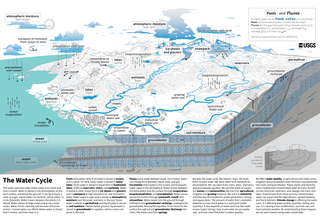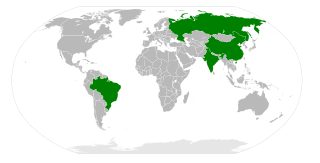
Globalization, or globalisation, is the process of interaction and integration among people, companies, and governments worldwide. The term globalization first appeared in the early 20th century, developed its current meaning some time in the second half of the 20th century, and came into popular use in the 1990s to describe the unprecedented international connectivity of the post-Cold War world. Its origins can be traced back to 18th and 19th centuries due to advances in transportation and communications technology. This increase in global interactions has caused a growth in international trade and the exchange of ideas, beliefs, and culture. Globalization is primarily an economic process of interaction and integration that is associated with social and cultural aspects. However, disputes and international diplomacy are also large parts of the history of globalization, and of modern globalization.

The Group of Eight (G8) was an inter-governmental political forum from 1997 until 2014. It had formed from incorporating Russia into the Group of Seven, or G7, and returned to its previous name after Russia was expelled in 2014.

The water cycle, also known as the hydrologic cycle or the hydrological cycle, is a biogeochemical cycle that describes the continuous movement of water on, above and below the surface of the Earth. The mass of water on Earth remains fairly constant over time but the partitioning of the water into the major reservoirs of ice, fresh water, saline water and atmospheric water is variable depending on a wide range of climatic variables. The water moves from one reservoir to another, such as from river to ocean, or from the ocean to the atmosphere, by the physical processes of evaporation, transpiration, condensation, precipitation, infiltration, surface runoff, and subsurface flow. In doing so, the water goes through different forms: liquid, solid (ice) and vapor. The ocean plays a key role in the water cycle as it is the source of 86% of global evaporation.

A service star is a miniature bronze or silver five-pointed star 3⁄16 inch (4.8 mm) in diameter that is authorized to be worn by members of the eight uniformed services of the United States on medals and ribbons to denote an additional award or service period. The service star may also be referred to as a campaign star or battle star depending on which award the star is authorized for and the manner in which the device is used for the award.

The Bombardier Global Express is a large cabin, 6,000 nmi / 11,100 km range business jet designed and manufactured by Bombardier Aviation . Announced in October 1991, it first flew on 13 October 1996, received its Canadian type certification on 31 July 1998 and entered service in July 1999. Initially powered by two BMW/Rolls-Royce BR710s, it shares its fuselage cross section with the Canadair Regional Jet and Challenger 600 with a new wing and tail. The shorter range Global 5000 is slightly smaller and the Global 6000 is updated and has been modified for military missions. The longer range Global 5500/6500 are powered by new Rolls-Royce Pearl engines with lower fuel burn and were unveiled in May 2018. The larger and stretched Global 7500/8000 have longer ranges.

The Group of Seven (G7) is an intergovernmental political forum consisting of Canada, France, Germany, Italy, Japan, the United Kingdom and the United States; additionally, the European Union (EU) is a "non-enumerated member". It is organized around shared values of pluralism, liberal democracy, and representative government. As of 2020, G7 members are large IMF advanced economies and account for over half of global net wealth, 30 to 43 percent of global gross domestic product, and 10 percent of the world's population. Its members maintain mutually close political, economic, diplomatic, and military relations in global affairs.

BRIC is a grouping acronym referring to the developing countries of Brazil, Russia, India, and China, which are identified as rising economic powers. It is typically rendered as "the BRIC", "the BRIC countries", "the BRIC economies", or alternatively as the "Big Four". The name has since been changed to BRICS after the addition of South Africa in 2010.

The G20 or Group of 20 is an intergovernmental forum comprising 19 countries and the European Union (EU). It works to address major issues related to the global economy, such as international financial stability, climate change mitigation and sustainable development.

Greenhouse gas emissions from human activities strengthen the greenhouse effect, contributing to climate change. Carbon dioxide, from burning fossil fuels such as coal, oil, and natural gas, is one of the most important factors in causing climate change. The largest emitters are China followed by the US, although the United States has higher emissions per capita. The main producers fueling the emissions globally are large oil and gas companies. Human-caused emissions have increased atmospheric carbon dioxide by about 50% over pre-industrial levels. The growing levels of emissions have varied, but have been consistent among all greenhouse gases. Emissions in the 2010s averaged 56 billion tons a year, higher than any decade before. Total cumulative emissions from 1870 to 2017 were 425±20 GtC from fossil fuels and industry, and 180±60 GtC from land use change. Land-use change, such as deforestation, caused about 31% of cumulative emissions over 1870–2017, coal 32%, oil 25%, and gas 10%.

Ancylolomia is a genus of moths of the family Crambidae described by Jacob Hübner in 1825.

In telecommunications, 5G is the fifth-generation technology standard for broadband cellular networks, which cellular phone companies began deploying worldwide in 2019, and is the successor to 4G networks which provide connectivity to most current cellphones.

Infurcitinea is a genus of the fungus moth family, Tineidae. Therein, it belongs to the Meessiinae, one of the larger fungus moth subfamilies.

Aplota is a genus of moths in the concealer moth family Oecophoridae.

BRICS is a grouping of the world economies of Brazil, Russia, India, China, and South Africa formed by the 2010 addition of South Africa to the predecessor BRIC. The original acronym "BRIC", or "the BRICs", was coined in 2001 by Goldman Sachs economist Jim O'Neill to describe fast-growing economies that would collectively dominate the global economy by 2050.
Ancylolomia palpella is a species of moth in the family Crambidae described by Michael Denis and Ignaz Schiffermüller in 1775. It is found in Belgium, France, Spain, Portugal, Italy, Austria, the Czech Republic, Slovakia, Poland, Hungary, Croatia, Romania, Bulgaria, the Republic of Macedonia, Albania, Greece, Ukraine, Russia, Transcaucasia, Asia Minor, Lebanon, the Palestinian territories, Iraq, Syria, Iran and Central Asia.
Glyphipterix palpella is a species of sedge moth in the genus Glyphipterix. It was described by Walsingham in 1914. It is found in Central America.

Pleurotinae is a subfamily of moths in the family Oecophoridae.
Lecithocera palpella is a moth in the family Lecithoceridae. It was described by John David Bradley in 1961. It is found on Guadalcanal in the Solomon Islands.

HMD Global, branded as HMD and Nokia Mobile, is a Finnish mobile phone manufacturer. The company is made up of the mobile phone business that Nokia sold to Microsoft in 2014, then bought back in 2016. HMD began marketing Nokia-branded smartphones and feature phones on 1 December 2016. The company has exclusive rights to the Nokia brand for mobile phones through a licensing agreement. The HMD brand is only used for corporate purposes and does not appear in advertising, whereas the name "Nokia Mobile" is used on social media.















